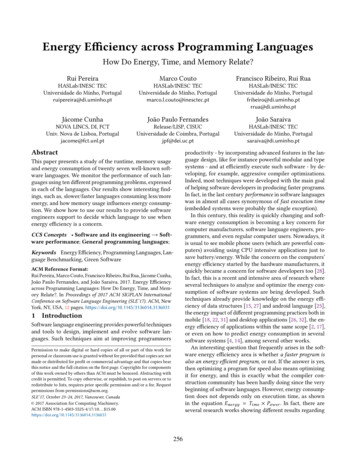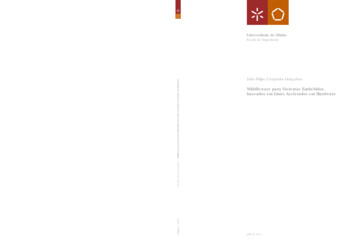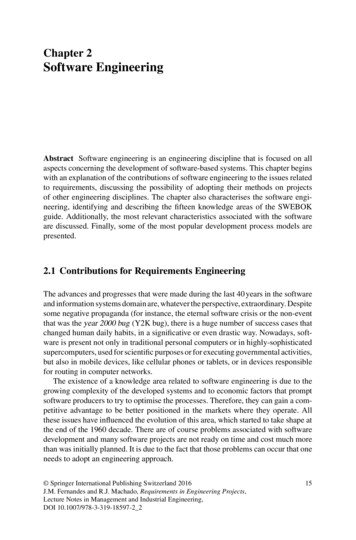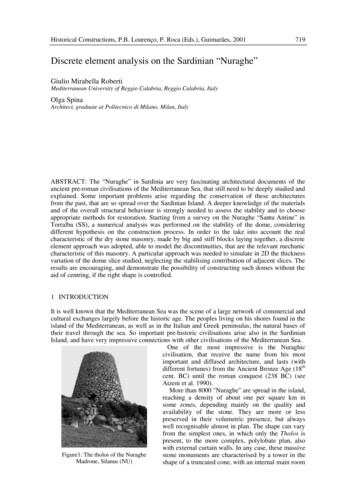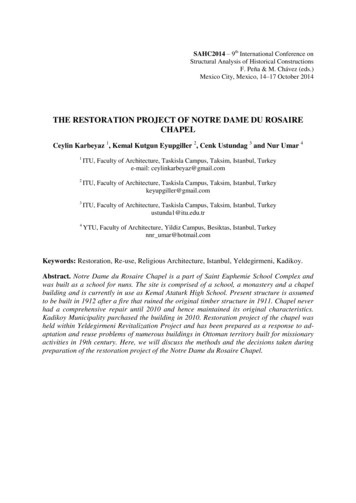
Transcription
- 1591 DETERIORATION ANO REPAIR OF MASONRY ARCH BRIDGESbyJ Page,D AlvesTransport & Road Research LaboratoryCrowthorneUnited KingdomD AshurstOve Arup & PartnersCoventryUnited KingdomABSTRACTThe masonry arch bridge is a vital part of the United Kingdom road network.The paper describes a condition survey of 98 arch bridges in Scotland andEngland.It examines water leakage through the arch soffit, spandrel walldefects, and arch ring defects and repairs. The Scottish bridges were foundto be in poorer condition than the English bridges; the harsher climate maybe responsible.A survey of the cost and effectiveness of repair andstrengthening techniques has a180 been made.It was found that there are avariety of inexpensive techniques which can be used to restore or enhance loadcapacity of the structure, often with no change to its externaI appearance.1IntroductionThere are about forty thousand brick or stone masonry arch bridges in theUnited Kingdom, representing about forty percent of the bridge stock. Veryfew have been built since the first world war and most of them are at leasta hundred years old.They have therefore reached the end of the presentnominal design life for UK bridges of 120 years.It would not however beeither practicable or desirable to replace them. The cost would be enormousand many make a positive contribution to the landscape.Many of them have deteriorated due to the effects of weathering and trafficand they may need to be repaired to maintain their function or strengthenedto increase their load carrying capacity.This paper discusses the commontypes of deterioration and the effectiveness and cost of some repair andstrengthening techniques.Typical construction of masonry arch bridges is shown in figure 1.CROSS-SECTIONParapetRoad baseWi ng wallStringcou rs eStone arch 4Figure 1Road surface.Multi-ring brick archTypical masonry arch bridge construction
- 1592 2Survey of 98 bridgesThe main purpose of the survey, carried out in 1989, was to examine the effectof different weather conditions on the condition of spandre1 walls. Outwardmovement of spandre1 wa11s is a common problem.They may either bulgelocally, move outwards as a whole, or tilt (or a combination of these). Thereare two likely mechanisms. ane is the horizontal force produced in the fillby wheel loads and transmitted to the spandrel wall. The second is an outwardforce produced on the spandrel wall by freezing of water in the fill in coldweather, causing it to expando Forty one bridges were examined in the northof Scotland which has a severe winter climate, eleven in south east Englandand forty six in south west England where the climates are milder. The surveyalso produced useful general information about arch bridges.As far aspossible the bridges were chosen at random and the results of the survey aresummarised in the next sections.2.1General description of the bridgesi)The spans varied from 1.5m to 3l.4m.the span range 2-16m.ii)Ninety one of the bridges were inSixty seven of the bridges were single span.iii) Seventy eight crossed a river, three a canal, and seventeen a railway(none crossed a road).iv) Twenty three of the arch rings were of brick, twenty seven of cut stone,forty two of random stone, one of concrete, and five of brick and stone.Twelve of the spandrel walls and parapets were of brick, twenty eight of cutstone, fifty six of random stone, one of brick and stone, and one of randomand cut stone.The construction materials reflected the readily availablebuilding materials in the three areas.vI Ninety of the bridges had arch rings whose shape was a segment of a circle.Two appeared to be parabolic and six were semi-elliptical.vi) Seventy six of the bridges had no skew. The remainder were fairly evenlydistributed over the range up to the maximum angle of 45 degrees.2.22.2.1ConditionWater leakage through the soffitTable 1 lists the severity of water leakage through the arch ring. A severitymarking (SM) of O denotes no leakage or local staining, a marking of 5 denoteswater dripping readily from the arch and heavy deposits of limescale or algae(the amount of water seen leaking from the arch will of course depend on therainfall prior to the survey, and this was not recorded). (Note:se Scotland, SW south west England, SE south east England) . Leakage of water into an arch bridge is undesirable because it is likely towash out fine particles in the fill, and if the water is acidic it willdissolve the lime in the mortar which was used in many of these bridges.The effect of freezing is likely to be more severe with saturated fill.Only Scotland had bridges where the leakage was classified as severe.
- 1593 -Percenta e of brid es with leakage severity marking SM:2.2.2SM OSM lSM 2SM 3SM 4SM 518.20.00.00.0Tab1e 1Degree of water 1eakage through the soffitSpandre1 wa11 defectsThe bridgesmovement ofrelative toinside edgewere examined for a variety of defects which indicate outwardspandre1 walls - leaning and bulging wa11s, outward movementthe arch ring, and longitudinal cracks in the arch beneath theof the spandrel wall. The presence of tie bars was also noted.Each defectThe markingsame persondefects andwas given a severity marking (SM) from 1 to 5 (O no defect).is arbitrary but a11 the bridges were surveyed and marked by theso the marking should be consistent.Table 2 summarises thetheir markings.IseSWSE% with 1eaning spandre1 wa11sMean defect severity marking29.31.730.41.69.12.0% with bu1ging spandre1 wa11sMean defect severity marking53.72.447.82.145.51.8% with outward movement re1ative to arch ringMean defect severitymarking63.42.143.52.427.32.3% with crack in arch ring beneath inside edgeof spandrel wallMean defect severity marking29.317.427.32.33.03.3%with any of the above defects80.5I65.2I54.5I(mean severity markin s do not include brid es"% with tie barsTab1e 2Spandre1 wa11 defectsThe bridges in Eng1and had fewer defects than the Scottish bridges, except for1eaning spandre1 walls.None of the bridges in SW England had tie bars,though a 1arger proportion (of a small sample) of bridges in SE England hadthem than in Scotland. The mean severity markings for the three areas appearto be quite similar.The evidence therefore suggests that the Scottish bridges have suffered moreoutward movement of spandrel walls than the English bridges.There are
- 1594 possible explanations for the difference other than climate, such asdifferences in building materiaIs or more heavy goods vehicles (HGVs) on theScottish bridges.An estimate was made of traffic flow during the inspection, but only a shortperiod was spent at each bridge so the reliability of the estimate cannot beassured (most bridges were also listed as having little HGV traffic).The closeness of traffic to the spandrel walls may affect the amount ofdamage. To examine this, the width of the footpath or verge has been comparedwith the total severity marking for the spandrel walls of each bridge.Nocorrelation was found. This should not however be taken to mean that allowingvehicles to traveI closer to a spandrel wall will not have an adverse effect,only that any such effect could not be isolated from the data.2.2.3Arch ring defecta and repairaThe arch ring soffits were examined for local bulges, cracks and missingmortar.The defects were given a severity marking of from 1 to 5. Repairswere also noted and a similar marking system was adopted, with a value of 1for minor repairs and 5 for major repairs affecting virtua1ly the whole arch.Table 3 summarises the results.seswSEPercentage with bulgesMean defect severity marking26.31.88.71.52.2Percentage with cracksMean defect severity marking23.72.910.91.440.02.0Percentage with missing mortarMean defect severity 83.2100.02.2n:.:'r- ity marking40.0Note:mean severity markings do not include bridges without the defect orrepairTable 3Arch ring defecta and repairaThe Scottish arch rings were in a poorer condition than those in SW England,with a higher proportion having one or more defects.This is despite asimilar proportion having had repairs, and about the sarne leveI of repairs.The bridges in SE England also had a high proportion of defects and all hadbeen repaired but the small size of the sarnple shou1d be borne in mind.3Repair and atrengthening techniqueaTable 4 identifies the common faults of arch bridges and the repair andstrengthening techniques which may be applied (some of the techniques will bedescribed in more detail later in the section).
- 1595 -II REPAIR/STRENGTHENINGFAULTArch ring thickness assessed to beinadequate to carry requiredtraffic 10adsSaddleSprayed concrete to soffitPrefabricated liner to soffitDeterioration of arch ringmaterialSaddleSprayed concrete to soffitPrefabricated liner to soffitGrout arch ringDeteriorated pointingRepointInternal deterioration of mortar eg separation between rings of amulti-ring brick archGrout arch ringFoundation movementMini-pileGrout piersUnderpin&abutmentsScour of foundationsUnderpinInvert slabOutward movement of spandrel wallsTie barsReplace fill with concreteTake down & rebuildGrout till i f it is suitableSeparation of arch ring beneathspandrel wall from rest of archringStitch (short tie bars spanning thecrack)Weak fillReplace till with concreteGrout till i f it is suitableWater leakage through arch ringWaterproof road surfaceWaterproof arch ring extrados improve drainageTable 4IArch bridge fau1ts and repair techniquesAn examination of these techniques was carried out in 1990 for TRRL byconsultants Ove Arup & Partners. Details were obtained of work done and costsfor about 180 bridges and then about 50 were selected for a more detailedexamination to identify the advantages and disadvantages of the various repairand strengthening techniques and their re1ative costs. An assessment of theeffectiveness of the techniques was made by inspectioni however the repairshad a11 been dane relatively recently so it was not possible to assess theirlong term effectiveness. Frequently more than one technique is applied to aparticular bridge. The costs identified were initial costs, the data were notavailable to attempt to identify whole life costs.3.1SaddlingSaddling involves removal of the fi11 and casting an in-situ concrete arch ontop of the existing arch.The new arch may be designed to act compositelywith the existing arch or to structura11y replace the existing arch, in effect
- 1596 using it as permanent formwork . Its advantage is that the work is invisibleonce completed but it requires a major construction operation to install.The only defects observed in the surveyed bridges strengthened using thistechnique were signs of weathering, discolouration and leachate encrustationon the arch soffit associated with water seepage which is common on masonryarches .3.2RepointingRoutine maintenance repointing is widely regarded as essential and may improvesignificantly arch load capacity by restoring the structurally effective archring thickness to its full depth . If properly done when it is needed, it mayprevent the bridge from deteriorating to the point where it needs moreexpensive repair work .If incorrectly done it can accelerate deteriorationof the structure (the mortar should not for instance be stronger than thebrick or stone). Repointing can enhance the appearance of the bridge and neednot disrupt traffic while being done.3.3Arch groutingArch grouting is used to fill voids in the arch ring to ensure that the fulldepth of section is available for load carrying.It is often used to fillvoids caused by ring separation in multi-ring brick arches.It does notaffect the appearance of the bridge unless grout extrudes from cracks and isnot removed (it may be necessary to repoint the arch ring first). The groutneeds to be carefully designed to avoid premature setting before it hascompletêly filled the voids and to ensure that its properties are compatiblewith the existing arch material.High pressure grouting may damage weakstructures. It will always take a line of least resistance which may be intofill, service ducts and drain pipes.The cases examined suggest that when properly applied it is an effectivestrengthening technique.3.4Sprayed concreteSprayed concrete is widely used as a means of increasing arch ring thicknessto increase load capacity, and of stabilising badly weathered masonry. Premixed concrete is sprayed at high velocity and it adheres on impact, fillingcrevices and compacting material already sprayed. A layer up to 300mm thickmay be applied; it is usually reinforced with at least nominal steel. It isquick to apply and does not involve disruption to traffic or services.Itreduces the size of the arch opening and it does not enhance the appearanceof the bridge although careful design can reduce its visual impactoAll the cases investigated showed signs of cracking, ma de visible by seepageof water and the assoc iated leaching of mineral sal ts.The 1 ining mayseparate from the original arch by shrinkage of the concrete or by furtherdeterioration of the arch material at the interface, which would mean that itwould not increase the load capacity as much as if it were fully attached.It was not possible to check this on the cases surveyed.3.5Prefabricated linersArch ring thickness is increased by attaching a corrugated metal or glass
- 1597 reinforced cement lining to the soffit as permanent formwork, and filling thespace between it and the arch ring with concrete or grout. As with sprayedconcrete, it is quick to apply and involves no disruption to traffic orservices, but it reduces the size of the arch opening and does not enhance theappearance of the bridge.Care needs to be taken to ensure that the spacebetween the arch and the formwork is fully filled with concrete or grout.No evidence of serious problems were found in the cases studied.However,rusting corrugated steel and fixing bolts were found, and grout loss at sheetjoints due to poor fito3.6 UnderpinningUnderpinning involves excavating material from beneath the foundations andreplacing with mass concrete. A sequence of work is followed to ensure thatthe stability of the existing structure is not compromised.The work islabour intensive. The cases studied appeared to have been successful.3.7 Invert slabsAn invert slab (see figure 1) is a slab of concrete placed between theabutment walls or piers with its top surface at or below river bed level(older versions may be built of masonry).It helps to prevent scour.Ifincorrectly installed however, there is a risk of scour beneath the slab,particularly at its downstream end, and this was found in one of the casesstudied.3.8Tie barsTie bars are used to restrain further outward movement of spandrel walls (seesection 2.2.2). They consist of a bar passing through the full width of thebridge, with pattress plates at each end, generally secured by a nut andwasher, to provide the restraint to the wall.If the arch ring requiresstrengthening at the same time a more common solution is to use a concretesaddle which will also relieve the spandrel wall of outward forces.In one of the cases studied there appeared to have been further movement ofa spandrel wall since installation of the tie bars. Rusting of the exposedparts, in one case severe, was also found.3.9Replacing some or all of the spandrel fill with concreteThis technique is used to stabilise outward movement of spandrel walls. Whenthe whole of the fill is replaced, the technique is akin to saddling and islikely to be used to deal with arch and wall problems at the same time. Thework is invisible once completed.Traffic and services are likely to bedisrupted during installation. Few defects were seen in the cases studied,except for the appearance of leachate.4Relative cost of repair methodsFrom the cost data collected during the survey it is possible to estimate thecost of various methods of repairing or strengthening an arch ring.As anexample a bridge with a semicircular arch of span 4.5m, headroom 3.5m (riseof arch plus height of abutment), total length at road surface 15m, and width6m has been examined. The costs (at 1990 prices) are given in figure 2.
- 1598 60-50-40-30-í2 Bu20[57 ,000TI[23 ,300-[1 5,300[10,80010O-Sr::::::;I[24,700 TI[4000mii!iii!Rep o intSpra y edarc h ringconcreteIt 150 mmlFigure 2 G raut1[269 / m 2 1Concrete sadd le Grout tedCorruga1[433 / m 2 1st ee l lin ingCost of various repair methods for example bridgeThe cost/m2 of grouting was significantly different for the two examplesexamined in the survey, so two costings are included in the figure.5ConclusionsThe condition survey showed that the Scottish bridges examined were generallyin poorer condition than the English bridges but the cause or causes could notbe isclated from the data available.The survey of repair and strengthening techniques showed no serious defectswith any of the techniques examined, although in some cases attention todetail is necessary. The costings suggest that if repointing is adequate torepair the deterioration present or if it gives an acceptable increase in loadcapacity then it should be used.lf this is not sufficient and if theappearance of the bridge is unimportant then sprayed conc rete is the cheapestoption. Grouting of voids in the arch ring has advantages when appearance isimportant and when disruption to traffic would be unacceptable. lf disruptionto traffic is acceptable then saddling may be a more reliable option thangrouting.6AcknowledgementsThe work described in this paper forms part of the programme of the BridgesDivision of the Structures Group of TRRL and the paper is published bypermission of the Director .(e) erown eopyright . The views expressed in this paper are not necessarilythose of the Scottish Development Department or the Department of Transport.Extracts from the text may be reproduced, except for comme r cial pu r poses,provided the source is acknowledged.
The masonry arch bridge is a vital part of the United Kingdom road network. The paper describes a condition survey of 98 arch bridges in Scotland and England. It examines water leakage through the arch soffit, spandrel wall defects, and arch ring defects and repairs. The Scottish bridges were found

